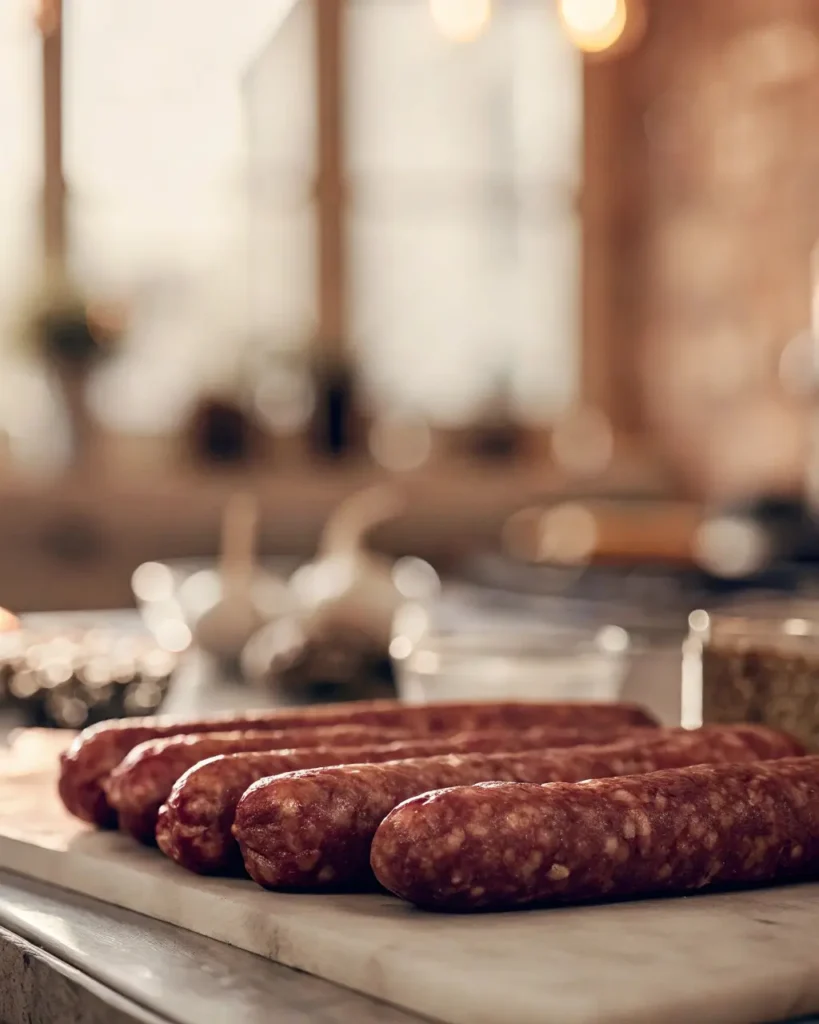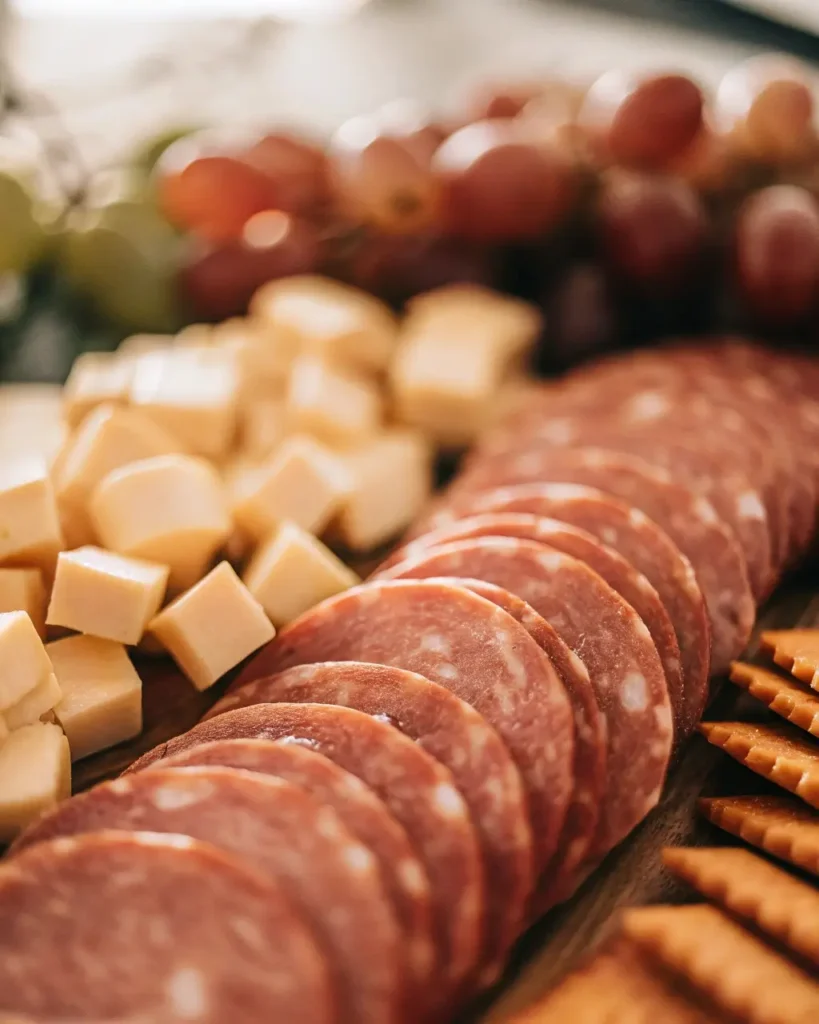Summer sausage has long been a beloved staple in American households. It shows up at holiday parties, in gift baskets, and even in your pantry during road trips or camping.
But this isn’t just another meat snack—summer sausage is a culinary tradition rooted in both necessity and flavor.
It’s shelf-stable, tangy, salty, and a little smoky. Whether eaten on its own or as part of a charcuterie board, it offers bold flavor in every bite.
This guide walks you through everything you need to know: how summer sausage is made, whether it’s safe to eat raw, what those mysterious white bits are, and why it shows up so often in winter—not summer.
We’ll even explore homemade versions, holiday traditions, and which brands you should trust.
Looking for inspiration? Try our hearty Shaved Ribeye Sandwich recipe—it pairs perfectly with slices of summer sausage for a rich lunch idea.
Jump to:
The Origin and Meaning of Summer Sausage
The History of Summer Sausage: From Farmhouse to Store Shelves
Before refrigeration was commonplace, preserving meat was a serious business—especially during hot summer months. That’s where summer sausage entered the scene. This cured meat has roots in old European food preservation techniques, particularly from German, Czech, and Polish immigrants who brought their recipes to the U.S.
Traditional summer sausage was designed to be made in winter and eaten in the summer. That’s right—families would prepare it during colder months when fresh meat was plentiful, then hang and cure the sausages to enjoy months later when refrigeration simply wasn’t available. This made it the perfect shelf-stable meat, and the name “summer sausage” was born.
Why Is It Called Summer Sausage? Origins Behind the Name
Contrary to what some might think, summer sausage isn’t a summer-only food. The name refers to its ability to be stored without refrigeration—making it ideal for hot weather when keeping meat cool was difficult. The use of salt, curing agents like sodium nitrate, and slow smoking made it possible to create a fermented sausage that could last for weeks (or months) without spoiling.
This practicality is what made summer sausage such a hit in early American households, and why it remains popular today. Plus, its tangy, savory flavor only improves over time, making it not just a storage solution, but a delicacy in its own right.
Don’t miss our Homemade Cheesy Pepperoni Stromboli, where summer sausage can be swapped in for an extra punch of flavor.
Ingredients and Preservation Process
What Is Summer Sausage Made Of? Meats, Spices, and Curing Agents
At its core, summer sausage is a type of cured meat made from a blend of ground beef and pork, although some recipes use wild game or even turkey. What gives this sausage its distinct flavor is a carefully balanced mix of spices—usually black pepper, mustard seed, garlic, coriander, and sometimes crushed red pepper for heat. But what really sets summer sausage apart is how it’s preserved.
Curing agents such as sodium nitrate or nitrite are added to prevent bacterial growth, maintain color, and extend shelf life. These ingredients, when combined with smoking or fermenting, give summer sausage its characteristic tang and make it safe to eat without refrigeration before opening.
Here’s a breakdown of the most common ingredients:
| Ingredient | Purpose |
|---|---|
| Ground beef/pork | Protein base |
| Garlic | Flavor and aroma |
| Mustard seed | Texture and tang |
| Sodium nitrite | Preservation and color retention |
| Sugar or dextrose | Feeds fermentation bacteria |
| Black pepper | Warmth and balance |
Check out our guide to Protein Cookie Dough for a snack idea that complements the boldness of summer sausage with a sweet protein-packed option.
How It Stays Safe Without Refrigeration: The Curing and Smoking Secrets
One of the most remarkable things about summer sausage is that it can sit out for days—or even weeks—without spoiling (before opening). That’s due to a few key techniques:
- Curing with Salt & Nitrates – These pull out moisture and stop bacteria growth.
- Fermentation – In many versions, lactic acid is produced by beneficial bacteria, which lowers the pH and adds that signature tang.
- Smoking – Slow smoking adds both flavor and preservative effects by drying the sausage and introducing antibacterial compounds.
These steps work together to turn raw meat into a shelf-stable sausage. It’s a brilliant mix of food science and culinary heritage. That’s also why summer sausage is often seen in survival kits, hiking packs, or holiday gift boxes—it doesn’t need refrigeration until you open it.

Discover great ideas like our Smoked Cream Cheese BBQ Party Tips to create the ultimate charcuterie board alongside your summer sausage.
Types and Regional Varieties
Popular Types of Summer Sausage Across America
Across the U.S., summer sausage takes on many forms—some rooted in old-world tradition, others born from regional innovation. While the base concept remains consistent (a cured, fermented, or smoked sausage that doesn’t require refrigeration before opening), the variations in taste, texture, and ingredients can be significant.
Here are the most popular types found in American kitchens and stores:
| Type | Description |
|---|---|
| Classic Beef & Pork | The most traditional version, often smoked and fermented with mustard seeds. |
| All-Beef Sausage | Made without pork, ideal for pork-free diets but still rich and savory. |
| Cheese-Stuffed | Packed with cheddar or jalapeño cheese—popular in the Midwest. |
| Spicy Jalapeño | Bold, hot, and perfect for heat lovers. Often paired with crackers or beer. |
| Game Meat Blends | Venison, elk, or bison-based for a wilder flavor and leaner texture. |
Regional preferences influence which type is most popular. For example, the Upper Midwest—especially Wisconsin—is known for cheese-filled summer sausage, while areas in the South lean into spicier versions.
If you love bold meat flavors, don’t miss our Black Pepper Angus Steak Panda Express recipe—a sizzling dish that pairs well with a side of sliced summer sausage.
How European Variations Influenced American Summer Sausage
The roots of American summer sausage trace back to Europe, where curing meats was a centuries-old necessity. German and Polish immigrants brought techniques for making dry sausages, including landjäger, cervelat, and salami. These sausages inspired the American version in both flavor and function.
Here’s how they compare:
| European Sausage | Influence on Summer Sausage |
|---|---|
| Salami | Inspired the tangy flavor and use of spices |
| Landjäger | Provided the concept of shelf-stable, dried meat |
| Cervelat | Contributed the blend of beef and pork with garlic |
Over time, American producers simplified and modified these recipes using available ingredients, resulting in the uniquely American summer sausage we love today. Its firm but sliceable texture, smoky aroma, and slight tanginess are all nods to its European roots.
Looking for a twist on sausage flavors? Check out our Calamari Steak recipe for another protein-packed delicacy with global flair.
Summer Sausage Flavor and Texture Profile
What Does Summer Sausage Taste Like? Salty, Smoky, Tangy Goodness
If you’ve never tasted summer sausage, you’re in for a unique flavor experience that’s hard to forget. It’s savory, tangy, slightly salty, and often has a hint of smoke. This complex flavor comes from the combination of curing, fermentation, and smoking processes.
The primary taste notes include:
- Umami-rich meatiness from beef or pork
- Tangy acidity from fermentation or added lactic acid
- Subtle smokiness from wood smoke like hickory or applewood
- Earthy spice from garlic, coriander, and mustard seed
Unlike fresh sausages, summer sausage is fully cooked or cured, giving it a more firm and sliceable texture. You won’t find the chew of a bratwurst or the greasiness of a pepperoni stick. Instead, you get smooth, balanced bites that hold their shape well—ideal for sandwiches, party trays, or snacking right from the wrapper.
Want to bring out those flavors even more? Discover our Cheesy Garlic Chicken Wraps that balance beautifully with a few slices of tangy summer sausage inside.
What Are the Little White Balls in Summer Sausage? Fat, Mustard Seeds, or Myths?
One of the most common questions about summer sausage is, “What are those little white spots?” While they can look mysterious (or even alarming), they’re perfectly normal and add to the flavor and texture.
These white specks are usually:
- Encapsulated fat – Adds richness and mouthfeel
- Mustard seeds – Deliver a tiny burst of spice
- Encapsulated citric acid – Used to quickly lower pH in some sausages for tanginess and preservation
They are not mold (unless the sausage is dry-cured and intentionally mold-aged, which is rare in U.S. commercial versions). Instead, they’re a key part of why summer sausage has such a distinctive bite.
For more textures that surprise the palate, try our Coconut Clusters recipe, which offers crunchy sweetness alongside the savory smoothness of sausage—perfect for charcuterie pairing.

Nutrition and Health Insights
Is Summer Sausage Healthy? Calories, Macros, and Keto-Friendly Value
For anyone keeping an eye on their diet, summer sausage can be both a tasty protein source and a potential dietary trap—it all depends on how it’s made and how much you eat. Let’s break it down:
| Nutrient | Per 1 oz Serving (Average) |
|---|---|
| Calories | 180–210 |
| Protein | 7–9g |
| Fat | 16–18g |
| Carbs | 0–2g |
| Sodium | 600–800mg |
From a keto or low-carb perspective, summer sausage is a solid choice—high in fat and protein, and low in carbs. It fits well into snack routines, especially paired with cheese, pickles, or nuts. Its long shelf life also makes it a go-to for road trips or emergency food kits.
However, moderation matters. Because summer sausage is cured and often high in sodium and saturated fat, overindulging can bump your daily intake of salt and calories.
If you’re looking for another high-protein treat, don’t miss our Protein Donuts—they’re sweet, satisfying, and easy to balance with your favorite meats.
Nitrates and Sodium: Are There Health Concerns to Consider?
One of the top concerns with cured meats like summer sausage is the use of nitrates or nitrites, which help preserve the meat and give it that deep pink color. These compounds can convert into nitrosamines when cooked at high heat, which are linked to some health risks. However, most store-bought sausages today use encapsulated citric acid or lower nitrate levels than decades ago.
Here’s what to keep in mind:
- Look for “no added nitrates” or “uncured” options if you’re nitrate-sensitive.
- Choose low-sodium varieties to keep your blood pressure in check.
- Balance your plate with fresh fruits, veggies, and fiber to offset processed food intake.
Bottom line? Summer sausage is safe to eat and enjoy occasionally, especially when paired with healthy sides and consumed mindfully.
Looking to clean up your sauces and condiments? Check out our Sugar-Free Caramel Syrup that brings sweetness without the blood sugar spike—perfect to pair with your high-protein meals.
Eating and Serving Summer Sausage
Is Summer Sausage Safe to Eat Raw? Understanding How It’s Prepared
One of the most common questions people ask is: Can I eat summer sausage without cooking it? The answer is a resounding yes.
Summer sausage is fully cooked, cured, and sometimes smoked before it ever hits store shelves. That means you don’t need to heat it up or fry it—unless you want to. The preservation process (curing with salt and sodium nitrite, followed by fermentation and/or smoking) ensures the meat is safe to eat straight out of the package.
Still, it’s best to:
- Check the label – Look for “fully cooked” or “ready to eat.”
- Refrigerate after opening – Even shelf-stable sausage needs chilling once unsealed.
- Avoid heating in the microwave – It can get rubbery. Instead, use a skillet or eat cold.
So yes, slicing into a stick of summer sausage for a quick snack is not only safe but encouraged. It’s perfect for camping trips, road snacks, or emergency food kits.
Want to turn it into a cozy winter meal? Try our Ham and Potato Soup and add some diced summer sausage for extra flavor and protein.
Best Ways to Eat Summer Sausage: Snacks, Platters, Sandwiches, and More
You can enjoy summer sausage in dozens of creative ways. Its versatility and savory bite make it an all-star addition to many dishes.
Here are some delicious ways to serve it:
| Serving Style | How to Use It |
|---|---|
| Charcuterie boards | Pair with cheeses, nuts, crackers, olives, and mustard |
| Breakfast hash | Dice and sauté with eggs, potatoes, and bell peppers |
| Grilled sandwiches | Add thin slices to grilled cheese or paninis |
| Pasta dishes | Cube it into baked mac & cheese or creamy pasta bowls |
| Holiday appetizers | Roll it in cream cheese and herbs for easy bites |
Whether you’re prepping for a game night, building school lunch boxes, or making gourmet snacks, summer sausage fits the bill.
Craving a warm, cheesy comfort food? Our Macaroni and Cheese Bowl gets even better with summer sausage stirred in right before baking.
Storage and Shelf Life
How Long Does Summer Sausage Last? Before and After Opening
One of the biggest advantages of summer sausage is its long shelf life. Thanks to curing, fermentation, and (often) smoking, this sausage is built to last.
Here’s a general guideline for storage:
| Condition | Shelf Life Estimate |
|---|---|
| Unopened, room temp | 1–3 months (check label) |
| Unopened, refrigerated | Up to 6 months |
| Opened, refrigerated | 2–3 weeks |
| Frozen | 6–9 months (best texture before 6) |
Always follow the “best by” date on the packaging. Most store-bought summer sausage is vacuum sealed, which slows down spoilage. Once opened, it’s important to wrap it tightly and refrigerate it to maintain freshness and safety.
Look for these signs it’s gone bad:
- A sour smell or slime on the surface
- A noticeable change in color (grayish tint)
- A tough or overly dried-out texture
For more storage-savvy recipes, check out our Easy Chicken Thighs Hominy Casserole—an ideal dish for using meats with longer fridge life.
Does It Need Refrigeration? Storing It Right to Keep the Flavor Intact
Here’s the key thing to remember: unopened summer sausage does not need refrigeration if it’s shelf-stable. That’s what makes it so appealing for travel, picnics, or keeping stocked in a pantry.
But once it’s sliced or the seal is broken? Straight into the fridge.
Here’s how to store it best:
- Wrap tightly in plastic wrap or foil
- Use airtight containers if storing in chunks or slices
- Freeze only if needed – texture can suffer slightly after thawing
Even though summer sausage can handle a bit of exposure, keeping it cool extends flavor, texture, and freshness. And let’s be honest—no one wants dry, rubbery sausage.
Planning a pantry overhaul? Our Keto Apple Pies are another shelf-stable snack that pairs beautifully with sausage on the go.
Popular Brands and Homemade Versions
Top U.S. Brands That Sell the Best Summer Sausage
When it comes to convenience and taste, several brands have made summer sausage a household name. Whether you’re picking up a snack tray or building a holiday gift box, these companies deliver on flavor, texture, and shelf life.
Here are some of the most loved options in the U.S. market:
| Brand | Notable Features |
|---|---|
| Hickory Farms | Holiday favorite, known for gift sets and cheddar pairings |
| Old Wisconsin | Traditional flavors, often available in larger stores |
| Johnsonville | Famous for brats, their summer sausage is rich and peppery |
| Omaha Steaks | Premium, gourmet-style sausage with gourmet cheese combos |
| Beef Stick Co. | Often sold online, known for beef-only, nitrate-free options |
Most of these brands offer a variety of flavors—classic, spicy, jalapeño-cheese, and even cranberry-infused. You can find them at major retailers or order online for convenience.
Looking for a homemade way to enjoy meat snacks? Check out our DIY Keto Vanilla Protein Powder—a great pantry item that complements protein-packed treats like summer sausage.
How to Make Your Own Summer Sausage at Home (Easy Recipe)
Making summer sausage at home might sound intimidating, but it’s actually quite doable with the right ingredients and a little patience. Homemade sausage also lets you control what goes in—no additives, nitrates, or mystery ingredients.
Here’s a basic homemade recipe (oven method):
Ingredients:
- 2 lbs ground beef (80/20)
- 2 tsp curing salt or celery powder
- 1 tbsp mustard seed
- 2 tsp garlic powder
- 2 tsp onion powder
- 1 tbsp cracked black pepper
- 1 tsp liquid smoke
- 1 tbsp brown sugar (optional)
Instructions:
- Mix all ingredients thoroughly in a large bowl.
- Roll into logs, wrap tightly in plastic wrap, and refrigerate for 24–48 hours.
- Preheat oven to 200°F.
- Bake uncovered on a wire rack over a baking sheet for 6 hours or until internal temp hits 160°F.
- Cool and store in the fridge up to 3 weeks, or freeze for longer.
Want a sweet pairing? Our Earl Grey Cookies offer a fragrant contrast to the smoky richness of sausage.
Making it yourself is not only fun—it’s fresher, more flavorful, and often cheaper than store-bought options.

Holiday and Cultural Relevance
Why Do We Eat Summer Sausage in Winter and Holidays?
You might wonder why summer sausage—named for its ability to withstand summer heat—is such a winter and holiday favorite. The answer goes back to its original purpose: long-term storage. Before refrigeration, meats cured in late fall were meant to be eaten through winter and early spring.
Over time, it became a staple in holiday food traditions. Its robust flavor, long shelf life, and easy portability made it a perfect addition to:
- Christmas gift baskets
- Thanksgiving appetizers
- New Year’s Eve charcuterie boards
It’s also closely tied to cultural food customs brought by European immigrants. In many German and Polish communities, summer sausage was shared at festive gatherings, often alongside pickled veggies and rye bread.
Looking for more holiday-ready recipes? Our Swiss Chocolate Chalet Cake is a must-try dessert to complement your sausage-laden charcuterie spread.
The Gift Tradition: Summer Sausage in Holiday Food Baskets
If you’ve ever received a food gift box, chances are it had a log of summer sausage inside. Why? It checks every box for the perfect gift:
- No refrigeration needed until opened
- Pairs well with crackers, cheese, and wine
- Feels nostalgic and comforting
Major brands like Hickory Farms and smaller artisan producers have made sausage gifting an annual ritual. It’s a warm, hearty gesture—and let’s face it, tastier than another fruitcake.
Want to build your own savory gift basket? Our Candied Cashews make a sweet-and-savory companion to sliced summer sausage.
Frequently asked questions
Why is it called summer sausage?
Because it can be stored safely without refrigeration, making it ideal to enjoy during the hot summer months—back when fridges weren’t common.
Is summer sausage ok to eat raw?
Yes. It’s fully cooked or cured, so it’s completely safe to eat straight from the package.
What does a summer sausage taste like?
It has a bold, tangy, and smoky flavor, balanced with spice and salt. The fermentation gives it a pleasant acidity, making it stand out from regular deli meats.
What are the little balls in summer sausage?
They’re usually fat particles, mustard seeds, or encapsulated citric acid—all safe and essential to flavor and texture.
Why do we eat summer sausage in winter?
Historically, it was preserved in winter and enjoyed throughout the season. Today, it’s a holiday tradition in gift baskets and charcuterie boards.
Is summer sausage and bologna the same thing?
No. While both are processed meats, bologna is emulsified and smooth, whereas summer sausage is coarser, tangier, and usually smoked or cured.
Conclusion: Why Summer Sausage Remains a Delicious Classic
Summer sausage is more than just a snack—it’s a culinary relic that continues to earn its place in kitchens, lunchboxes, holiday spreads, and food baskets. Its blend of convenience, flavor, and history makes it a uniquely American food with old-world charm. Whether you buy it or make it from scratch, it’s the kind of comfort food that’s always welcome.
Learn more about classic meat pairings in our Sausage Tortellini Soup recipe—where summer sausage could be a creative swap for added smoky flavor.
PrintSummer Sausage: How to Make It at Home
Learn how to make flavorful, preservative-free summer sausage at home with this simple step-by-step guide. Customize the recipe with your favorite spices for a delicious and healthy snack!
- Prep Time: 30 minutes
- Cook Time: 2-3 hours
- Total Time: ~3 days (including curing)
- Yield: 4-6 servings
- Category: Snacks
- Method: Smoking or Baking
- Cuisine: American
- Diet: Gluten Free
Ingredients
- 2 lbs ground beef (90% lean)
- 2 tsp salt
- 1 tsp curing salt
- 1 tsp garlic powder
- 1 tsp mustard seed
- 1 tsp black pepper
- 1/2 tsp smoked paprika
- 1/2 cup water
- Optional: 1/2 cup diced cheese or jalapeños
Instructions
- Combine ground beef, salt, curing salt, garlic powder, mustard seed, black pepper, and smoked paprika in a bowl. Mix well.
- Gradually add water, mixing until the meat mixture feels tacky.
- Stuff the mixture into sausage casings, ensuring no air pockets. Tie off the ends.
- Refrigerate the sausages to cure for 24-48 hours.
- Preheat smoker to 180°F or oven to 170°F.
- Smoke sausages until internal temperature reaches 160°F (about 2-3 hours).
- Cool completely before slicing or storing.
Notes
- For a smoky flavor, use hickory or applewood chips in the smoker.
- Oven-baked sausages benefit from adding a water pan for moisture.
- Refrigerate sausages for up to two weeks or freeze for longer storage.


